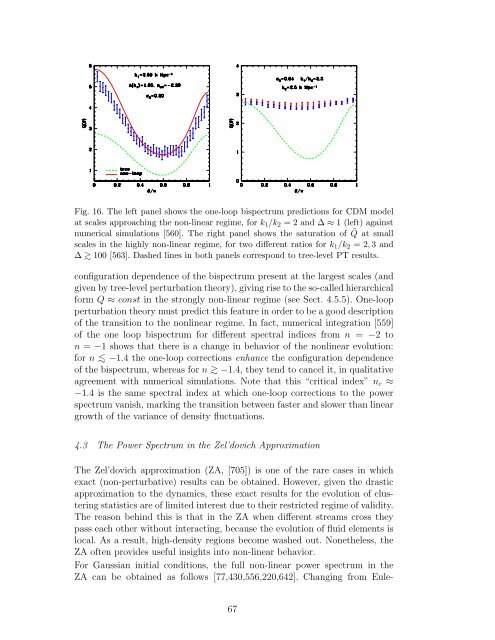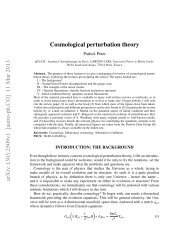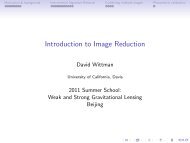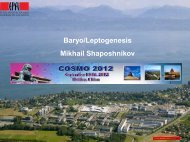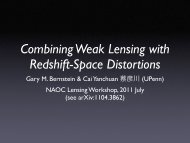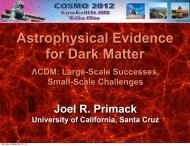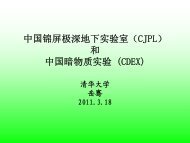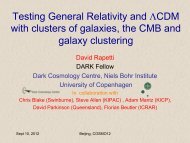- Page 1 and 2:
arXiv:astro-ph/0112551v1 27 Dec 200
- Page 3 and 4:
4.1.1 Emergence of Non-Gaussianity
- Page 5 and 6:
6.11.1 Maximum Likelihood Estimates
- Page 7 and 8:
1 Introduction and Notation Underst
- Page 9 and 10:
with N-point functions, whereas Cha
- Page 11 and 12:
Table 3 Notation for the Cosmic Fie
- Page 13 and 14:
2 Dynamics of Gravitational Instabi
- Page 15 and 16: In the following we will only use c
- Page 17 and 18: ∂u(x, τ) + H(τ) u(x, τ) = −
- Page 19 and 20: Eq. (17) we can write the vorticity
- Page 21 and 22: θn(k) = d 3 q1 . . . d 3 qn δD(k
- Page 23 and 24: 2.4.3 Cosmology Dependence of Non-L
- Page 25 and 26: approximation f(Ωm, ΩΛ) = Ω3
- Page 27 and 28: The somewhat complicated expression
- Page 29 and 30: where Φ denotes the gravitational
- Page 31 and 32: or more precisely D2(τ) ≈ − 3
- Page 33 and 34: ever turning around, washing out st
- Page 35 and 36: 2.9.2 Direct Summation Also known a
- Page 37 and 38: (e.g., [314,532]). Finally, it is w
- Page 39 and 40: such initial conditions are likely
- Page 41 and 42: 3.2.1 Statistical Homogeneity and I
- Page 43 and 44: δ 1 δ δ 2 3 c = δ1 c = 00000 11
- Page 45 and 46: 3.2.5 Probabilities and Correlation
- Page 47 and 48: 3.3.3 Generating Functions It is co
- Page 49 and 50: values of y are then also of the or
- Page 51 and 52: 4 From Dynamics to Statistics: N-Po
- Page 53 and 54: Figures 5 and 6 show the tree diagr
- Page 55 and 56: e approximated by a fitting functio
- Page 57 and 58: Fig. 10. The tree-level three-point
- Page 59 and 60: 4 2 0 0.2 0.4 0.6 0.8 0.2 0.4 0.6 0
- Page 61 and 62: n P13/(πA 2 a 4 ) P22/(πA 2 a 4 )
- Page 63 and 64: Fig. 13. The power spectrum for n =
- Page 65: where: B222 ≡ 8 d 3 qPL(q, τ)F
- Page 69 and 70: them in Sect. 5.6. It is worth emph
- Page 71 and 72: Fig. 17. The reduced bispectrum ˜
- Page 73 and 74: (1) There are no characteristic tim
- Page 75 and 76: velocity exactly cancels the Hubble
- Page 77 and 78: A simple generalization of this arg
- Page 79 and 80: growth factor has been written as D
- Page 81 and 82: function in the stable clustering l
- Page 83 and 84: S sat 4 (n) = 16 Qsat 4 (n) = 8 54
- Page 85 and 86: For the reasons discussed in Sect.
- Page 87 and 88: δ δ Evolution of an initially und
- Page 89 and 90: obtained by expansion about Ωm =
- Page 91 and 92: y the orthogonality relation betwee
- Page 93 and 94: σ = 2 ; ν σ = ; 4 2 ν σ = 6 3
- Page 95 and 96: (that plays a role similar to the v
- Page 97 and 98: Fig. 26. The predicted Sp parameter
- Page 99 and 100: Table 6 Tree-level and one-loop cor
- Page 101 and 102: expressed in terms of the linear de
- Page 103 and 104: give to non-Gaussian initial condit
- Page 105 and 106: + −4 + 8 3 SG 3 − 1 S 6 G 2 3
- Page 107 and 108: the initial conditions. In Sect. 2.
- Page 109 and 110: Fig. 30. The ratio of the tree-leve
- Page 111 and 112: 5.8 The Density PDF Up to now, we h
- Page 113 and 114: Fig. 32. Comparison between predict
- Page 115 and 116: 9 5 p(δ) = 3/2 4π Ns(1 + δ) 3 σ
- Page 117 and 118:
Table 10 Parameters of the singular
- Page 119 and 120:
5.10.2 The Shape of the PDF The abo
- Page 121 and 122:
Fig. 35. Example of a joint PDF of
- Page 123 and 124:
Table 11 The coefficients a1,... ,a
- Page 125 and 126:
originally in previous work in the
- Page 127 and 128:
Table 12 Parameters used in fit (35
- Page 129 and 130:
6 From Theory to Observations: Esti
- Page 131 and 132:
the size of the catalog and optimiz
- Page 133 and 134:
The cosmic error is most useful whe
- Page 135 and 136:
expectation number ¯ N = ¯ngv, P
- Page 137 and 138:
1 〈δn(k1)δn(k2)δn(k3)〉 = N2
- Page 139 and 140:
catalog, the latter being equivalen
- Page 141 and 142:
size. In this regime, where ξ(r) i
- Page 143 and 144:
The expressions (395) and (400) can
- Page 145 and 146:
The techniques developed to measure
- Page 147 and 148:
At smaller scales, in the regime k
- Page 149 and 150:
Fig. 38. The top panel shows the me
- Page 151 and 152:
If ¯ng is determined with arbitrar
- Page 153 and 154:
Factorial moments thus verify Fk =
- Page 155 and 156:
To second order the cosmic bias [Eq
- Page 157 and 158:
The finite-volume error comes from
- Page 159 and 160:
6.7.5 Cosmic Error and Cosmic Bias
- Page 161 and 162:
factorial moment correlators [620]
- Page 163 and 164:
The generalization of Eq. (422) rea
- Page 165 and 166:
in [152]. Similarly to Eq. (472), t
- Page 167 and 168:
constrain theories with observation
- Page 169 and 170:
From this simple result, we see tha
- Page 171 and 172:
Fig. 41. The cosmic distribution fu
- Page 173 and 174:
of functions of the data ˆx. The p
- Page 175 and 176:
6.11.2 Quadratic Estimators In real
- Page 177 and 178:
is positive and compact in Fourier
- Page 179 and 180:
6.12 Measurements in N-Body Simulat
- Page 181 and 182:
7 Applications to Observations 7.1
- Page 183 and 184:
properties of the matter distributi
- Page 185 and 186:
deterministic bias results hold for
- Page 187 and 188:
effects due to the gravitational dy
- Page 189 and 190:
0000 1111 0000 1111 ϕ (y)= 0000 11
- Page 191 and 192:
where the volume V = 4πR3 /3 is re
- Page 193 and 194:
in Sect. 7.1.3, Eq. (555), plus Eqs
- Page 195 and 196:
In the following we first review th
- Page 197 and 198:
if the 3D correlation function is
- Page 199 and 200:
Table 13 Projection factors for dif
- Page 201 and 202:
Note that the rp coefficients are v
- Page 203 and 204:
Fig. 47. Tree-level PT predictions
- Page 205 and 206:
7.3 Weak Gravitational Lensing The
- Page 207 and 208:
elation (598) is then entirely dime
- Page 209 and 210:
7.4 Redshift Distortions In order t
- Page 211 and 212:
where [δD]n ≡ δD(k − k1 −
- Page 213 and 214:
proximation. In fact, Eq. (616) is
- Page 215 and 216:
Fig. 48. The left panel shows the b
- Page 217 and 218:
They obtained analogous results to
- Page 219 and 220:
that for wide surveys such as 2dFGR
- Page 221 and 222:
Machine, [374]) and COSMOS [421] mi
- Page 223 and 224:
Table 14 Angular Catalogs. The firs
- Page 225 and 226:
The DeepRange Catalog ([530] 1998)
- Page 227 and 228:
Fig. 50. The two-point angular corr
- Page 229 and 230:
Fig. 51. The APM 3D power spectrum
- Page 231 and 232:
linearization first done in [289] a
- Page 233 and 234:
most of the measurements only probe
- Page 235 and 236:
and Rb = 4.3 ± 1.2 [226]. These re
- Page 237 and 238:
3 2 1 3 2 1 0 -1 10 5 0 -5 -10 0 90
- Page 239 and 240:
Table 16 The reduced skewness and k
- Page 241 and 242:
estimations are split in its 6 × 6
- Page 243 and 244:
the near future. An early applicati
- Page 245 and 246:
The Stromlo-APM redshift survey ([4
- Page 247 and 248:
A recent linear analysis of the LCR
- Page 249 and 250:
at the non-linear scale, and no sig
- Page 251 and 252:
Fig. 57. The redshift-space reduced
- Page 253 and 254:
Table 19 Some measurements of S3 an
- Page 255 and 256:
Fig. 60. The redshift-space skewnes
- Page 257 and 258:
such as the abundance of massive cl
- Page 259 and 260:
the weakly non-linear regime is qui
- Page 261 and 262:
the mock catalogs. The resulting 3D
- Page 263 and 264:
few technical issues that need more
- Page 265 and 266:
A The Spherical Collapse Dynamics T
- Page 267 and 268:
More specifically we define ϕ(y) a
- Page 269 and 270:
∞ (−τ1) τ2 =ξ y1 νp p=1 p
- Page 271 and 272:
This result writes as a kind of com
- Page 273 and 274:
E PDF Construction from Cumulant Ge
- Page 275 and 276:
E.3 Approximate Forms for P(ρ) whe
- Page 277 and 278:
A simple change of variable, t 1−
- Page 279 and 280:
It is then easy to calculate cross-
- Page 281 and 282:
References [1] S.J. Aarseth, E.L. T
- Page 283 and 284:
[54] F. Bernardeau, R. Van De Weyga
- Page 285 and 286:
[100] A. Buchalter, M. Kamionkowski
- Page 287 and 288:
[150] S. Colombi, F.R. Bouchet, L.
- Page 289 and 290:
[196] G. Efstathiou, in Cosmology a
- Page 291 and 292:
[245] A. Gangui, Phys. Rev. D, 62,
- Page 293 and 294:
[299] A.J.S. Hamilton, M. Tegmark,
- Page 295 and 296:
[352] R. Jeannerot, Phys. Rev. D, 5
- Page 297 and 298:
[399] A.R. Liddle, D.H. Lyth, Phys.
- Page 299 and 300:
[448] P. McDonald, J. Miralda-Escud
- Page 301 and 302:
[497] J.A. Peacock, S. Cole, P. Nor
- Page 303 and 304:
[547] R.F. Sanford, 1917, Lick Obse
- Page 305 and 306:
[597] M. Snethlage, Metrica, 49, (1
- Page 307 and 308:
[644] A.N. Taylor, P.I.R. Watts, MN
- Page 309:
[692] M.B. Wise, in The Early Unive


